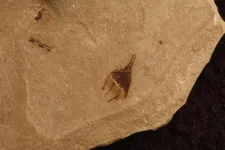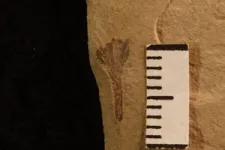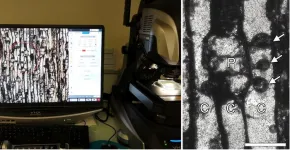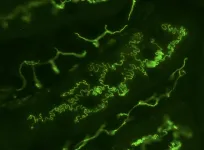(Press-News.org) Botanists and paleontologists, led by researchers from the University of Colorado Boulder, have identified a fossil chili pepper that may rewrite the geography and evolutionary timeline of the tomato plant family.
The team’s findings, published last month in the journal New Phytologist, show that the chili pepper tribe (Capsiceae) within the tomato, or nightshade (Solanaceae), family is much older and was much more widespread than previously thought. Scientists previously believed that chili peppers evolved in South America at most 15 million years ago, but the new research pushes that date to at least 50 million years ago—and suggests that chili peppers were in fact present in North America at that time.
Rocío Deanna, a postdoctoral researcher in ecology and evolutionary biology, and Abel Campos, an undergraduate double majoring in evolutionary biology and molecular, cellular and developmental biology, weren't planning to rewrite history when they met up one afternoon at the CU Boulder Museum of Natural History in 2021. Yet among a group of specimens in its collections gathered from the Green River Formation—geological treasure trove in northwestern Colorado and southwestern Wyoming—Deanna spotted a specific, solanaceous trait embedded in one fossil: little spikes on the end of a fruiting stem.
“At first, I thought ‘No way! This can’t be true,’” said Rocío Deanna, lead author of the study. “But it was so characteristic of the chili pepper.”
After they discovered two of these fossils in the CU Boulder collections, Deanna and Campos, a co-author of the study, found one more from the chili pepper tribe in collections at the Denver Museum of Nature and Science. All three fossils are from the Green River Formation in Colorado: the CU specimens from Garfield County and the DMNS fossil from Rio Blanco County.
These chili pepper fossils from the Eocene geological epoch (34 to 56 million years ago) match the timeline of another nightshade fossil found in the Esmeraldas Formation in Colombia, revealing that the family was already distributed across all of the Americas by as early as 50 million years ago.
“The family is way older than we thought,” said Deanna, also a faculty member at the National University of Cordoba.
A fruit-fossil history
The nightshade family comprises 3,000 species and almost 100 different genera, including chili peppers. The ancient chili pepper was technically a fruit—and a berry, at that. While tomatoes and peppers are commonly associated with vegetables, they have seeds on the inside, which officially categorizes them as fruits.
The researchers cannot be sure of the chili’s exact shape or color, but it was probably on the smaller end compared to modern day chili peppers. And like its relatives, it could have been quite spicy, according to Deanna.
Deanna and Campos identified the fossil by the unique shape of its calyx teeth: spikes on the end of the fruiting stem that hold on to the pepper, like those which hold a gemstone in a ring.
“The world has maybe 300,000 plant species. The only plants with that kind of calyx is this group of 80 or 90 species,” said Stacey Smith, senior author of the paper and associate professor of evolutionary biology at CU Boulder.
Paleontologists collected the CU Boulder fossil from the Green River Formation in the 1990s. But its exact identity remained a mystery for years, in part because there are only a handful of “solanologists,” botanists who study the nightshade family, in the world. When Deanna found these Colorado-based fossils, she had just returned from a global search for tomato family fossil specimens, only to find some “just ripe for the picking” right on campus.
“A lot of discoveries happen decades after the specimens have been collected,” said Smith. “Who knows how many other new fossil species are sitting in any of these museums? They're just waiting for the right eyes to look at them.”
Trickle-down evolution
These chili pepper fossils were around during the Eocene, a geologic epoch that lasted from about 34 to 56 million years ago as the continents drifted toward their present positions. During this balmy time in Earth’s history, carbon dioxide levels ranged between 700 and 900 parts per million (twice as high as they are today), and palm trees grew as far north as Alaska. Because little to no ice was present on Earth, sea level was as much as 500 feet higher than it is today.
Scientists had assumed that the origins of chili peppers began in South America roughly 10 to 15 million years ago, where they then dispersed over land and water to the other continents. While Colorado today is home to very few native nightshades and no chili peppers, this new discovery hints that a plethora of plants from the tomato plant family may have existed in North America 40 to 50 million years ago, which have since largely disappeared.
But how did these peppers first get to North America? It’s now a case of “the chicken or the chili pepper?”
Experts have theorized that fruit-eating birds, which existed as early as 60 million years ago, may have carried seeds and plants around the world with them in their guts, stuck to their feathers or in the mud on their feet. But these birds also had to be eating something to fuel their journeys—and fleshy berries, or peppers, make the perfect fuel. Birds may have distributed peppers from continent to continent, but peppers may also have been crucial to the success of those same birds.
So the nightshade family could have easily started in North America instead of South America, then dispersed in the other direction—and with this discovery, scientists can no longer say for sure, said Smith.
“These chili peppers, a species that we thought arose in an evolutionary blink of an eye, have been around for a super long time,” said Smith. “We're still coming to grips with this new timeline.”
Additional authors on this publication include: Camila Martínez, Universidad EAFIT and Smithsonian Tropical Research Institute; Steven Manchester, Florida Museum of Natural History, University of Florida; Peter Wilf, Pennsylvania State University; Sandra Knapp, Natural History Museum, London; Franco E. Chiarini, Gloria E. Barboza, and Gabriel Bernardello of the Instituto Multidisciplinario de Biologia Vegetal, IMBIV (CONICET-UNC); Herve Sauquet, National Herbarium of New South Wales and Evolution and Ecology Research Centre, University of New South Wales; Ellen Dean, Center for Plant Diversity, University of California; Andres Orejuela, Grupo de Investigacion en Recursos Naturales Amazonicos – GRAM, Facultad de Ingenierıas y Ciencias Basicas, Instituto Tecnol ogico del Putumayo, and Subdireccion cientıfica, Jardın Botanico de Bogota Jose Celestino Mutis.
END
New study uncovers Colorado’s spicy ancient history of chili peppers
A case of “the chicken or the chili pepper?" and coming to grips with a new timeline
2023-04-21
ELSE PRESS RELEASES FROM THIS DATE:
360-million-year-old Irish fossil provides oldest evidence of plant self-defense in wood
2023-04-21
An international team of scientists, co-led by Dr Carla J. Harper, Assistant Professor in Botany in the School of Natural Sciences at Trinity, has discovered the oldest evidence of plant self-defence in wood in a 360-million-year-old fossil from south-eastern Ireland.
Plants can protect their wood from infection and water loss by forming special structures called “tyloses”. These prevent bacterial and fungal pathogens from getting into the heartwood of living trees and damaging it. However, it was not previously known how early in the evolution of plants woody species became capable of forming such defences.
Published ...
New paper advances understanding of geographic health disparities
2023-04-21
By looking at where people were born instead of where they ultimately move to and die, geographic disparities in mortality look different than previously assumed, according to a new study published on April 1, 2023, in the journal Demography.
interstate migration may mitigate regional inequalities in mortality according to “Understanding Geographic Disparities in Mortality,” a paper led by Jason Fletcher, professor in the La Follette School of Public Affairs at the University of Wisconsin–Madison and director of the Center for Demography of Health and Aging with an appointment in Population Health Sciences.
“At a time when nearly ...
Newly funded Morris Animal Foundation study assesses CBD use for postsurgical pain in dogs
2023-04-21
DENVER/April 21, 2023 – A new study is testing whether the addition of CBD can improve pain management in dogs following orthopedic surgery. The study, funded by Morris Animal Foundation, will be conducted by a veterinary research team at the University of Saskatchewan, Canada.
CBD use in pets has gained in popularity in the last decade, but there are few controlled studies closely examining its efficacy as a pain management tool. This study hopes to help partially close this knowledge gap.
The research team, led by Dr. Alan Chicoine, Assistant Professor, Department ...
Endocrine Society endorses bipartisan bill to address insulin affordability
2023-04-21
WASHINGTON—The Endocrine Society today endorsed the Improving Needed Safeguards for Users of Lifesaving Insulin Now (INSULIN) Act of 2023, a bipartisan insulin affordability bill introduced by Sens. Jeanne Shaheen (D-NH) and Susan Collins (R-ME). This legislation would cap out-of-pocket insulin costs for those with private insurance, ensure patients can share in insulin rebates and discounts, and promote competition in the insulin market.
These measures would protect access to life-saving insulin for more than 7 million people nationwide who rely on the medication to manage their diabetes. According to the U.S. Center for Disease Control ...
Biological age is increased by stress and restored upon recovery
2023-04-21
The biological age of humans and mice undergoes a rapid increase in response to diverse forms of stress, which is reversed following recovery from stress, according to a study publishing on April 21 in the journal Cell Metabolism. These changes occur over relatively short time periods of days or months, according to multiple independent epigenetic aging clocks.
“This finding of fluid, fluctuating, malleable age challenges the longstanding conception of a unidirectional upward trajectory of biological age over the life course,” says co-senior study author James White of Duke University School of Medicine. “Previous reports ...
Most people feel “psychologically close” to climate change
2023-04-21
When spurring action against climate change, NGOs and governmental agencies frequently operate on the assumption that people are unmotivated to act because they view climate change as a problem that affects distant regions far in the future. While this concept, known as psychological distance, seems intuitive, researchers report in the journal One Earth on April 21 that most people see climate change as an important and timely issue even if its impacts are not immediately noticeable.
“There is no consistent evidence ...
The Mathematics of Cell Boundary 'Ruggedness'
2023-04-21
Fukuoka, Japan—Researchers have uncovered both the mathematical and biological mechanism behind the rugged structures at cell boundaries found in tissues such as the kidneys and nasal glands. The team hopes that their new insights can help develop new ways of treating associated pathologies and build better biological models for future study.
Our cells come in all sorts of shapes and sizes. From the neurons that extend across the central nervous system, to the spherical white blood cells that protect us from infection, a cell's form and ...
Effect of COVID-19 pandemic on food insecurity and inability to pay rent hit immigrant families hardest, Drexel study finds
2023-04-21
Under embargo until April 21, 2023
Although families with immigrant mothers experienced higher rates of food insecurity and inability to pay rent during the pandemic than other groups, they reported less participation in economic impact payments (EIP) in the form of stimulus checks and the Supplemental Nutrition Assistance Program (SNAP) – two programs designed to provide stopgap financial support, according to a new study in JAMA Health Forum from researchers at the Dornsife School of Public Health and Children’s HealthWatch.
The team surveyed 1,396 caregivers in Boston, ...
Firearms injure or kill up to a quarter of juvenile justice youth after detention
2023-04-21
CHICAGO – A new study by Northwestern University found that among youth who had entered juvenile detention, one-quarter of Black and Hispanic males were later injured or killed by firearms within 16 years.
While the nation’s youth and young adults are disproportionately affected by the daily occurrence of 100 firearm deaths and 234 non-fatal firearm injuries, youth who have been previously involved with the juvenile justice system had up to 23 times the rate of firearm mortality than the general population.
The study is the first to focus on the incidence rate of firearm injuries and death within the juvenile justice population.
“Who ...
Neighborhood disadvantage and breast cancer–specific survival
2023-04-21
About The Study: In this study of 5,000 patients with breast cancer, a shorter breast cancer–specific survival in women from disadvantaged neighborhoods compared with advantaged neighborhoods was identified, even after controlling for individual-level sociodemographic, comorbidity, breast cancer risk factor, access to care, tumor, and National Comprehensive Cancer Network guideline-concordant treatment characteristics. The findings suggest potential unaccounted mechanisms, including unmeasured social determinants of health and access to care measures.
Authors: Neha Goel, M.D., of the University of Miami Miller School of Medicine, is ...
LAST 30 PRESS RELEASES:
Injectable breast ‘implant’ offers alternative to traditional surgeries
Neuroscientists devise formulas to measure multilingualism
New prostate cancer trial seeks to reduce toxicity without sacrificing efficacy
Geometry shapes life
A CRISPR screen reveals many previously unrecognized genes required for brain development and a new neurodevelopmental disorder
Hot flush treatment has anti-breast cancer activity, study finds
Securing AI systems against growing cybersecurity threats
Longest observation of an active solar region
Why nail-biting, procrastination and other self-sabotaging behaviors are rooted in survival instincts
Regional variations in mechanical properties of porcine leptomeninges
Artificial empathy in therapy and healthcare: advancements in interpersonal interaction technologies
Why some brains switch gears more efficiently than others
UVA’s Jundong Li wins ICDM’S 2025 Tao Li Award for data mining, machine learning
UVA’s low-power, high-performance computer power player Mircea Stan earns National Academy of Inventors fellowship
Not playing by the rules: USU researcher explores filamentous algae dynamics in rivers
Do our body clocks influence our risk of dementia?
Anthropologists offer new evidence of bipedalism in long-debated fossil discovery
Safer receipt paper from wood
Dosage-sensitive genes suggest no whole-genome duplications in ancestral angiosperm
First ancient human herpesvirus genomes document their deep history with humans
Why Some Bacteria Survive Antibiotics and How to Stop Them - New study reveals that bacteria can survive antibiotic treatment through two fundamentally different “shutdown modes”
UCLA study links scar healing to dangerous placenta condition
CHANGE-seq-BE finds off-target changes in the genome from base editors
The Journal of Nuclear Medicine Ahead-of-Print Tip Sheet: January 2, 2026
Delayed or absent first dose of measles, mumps, and rubella vaccination
Trends in US preterm birth rates by household income and race and ethnicity
Study identifies potential biomarker linked to progression and brain inflammation in multiple sclerosis
Many mothers in Norway do not show up for postnatal check-ups
Researchers want to find out why quick clay is so unstable
Superradiant spins show teamwork at the quantum scale
[Press-News.org] New study uncovers Colorado’s spicy ancient history of chili peppersA case of “the chicken or the chili pepper?" and coming to grips with a new timeline






